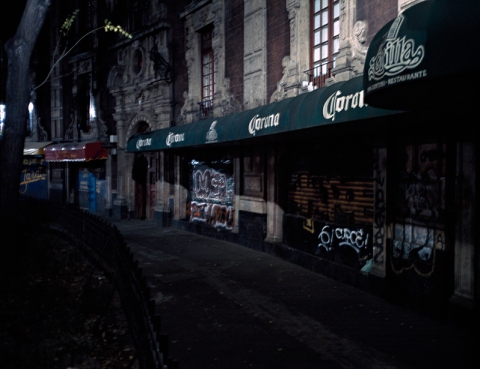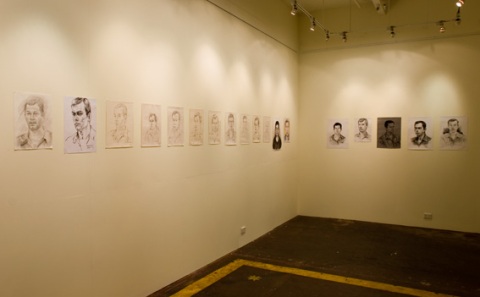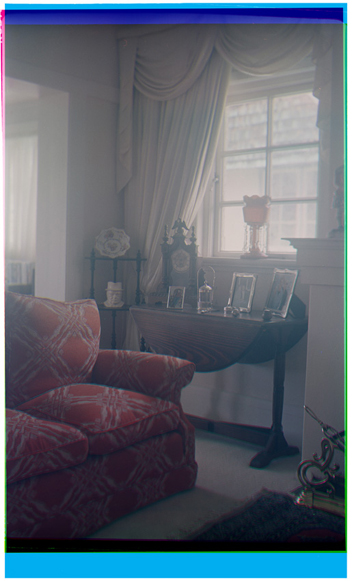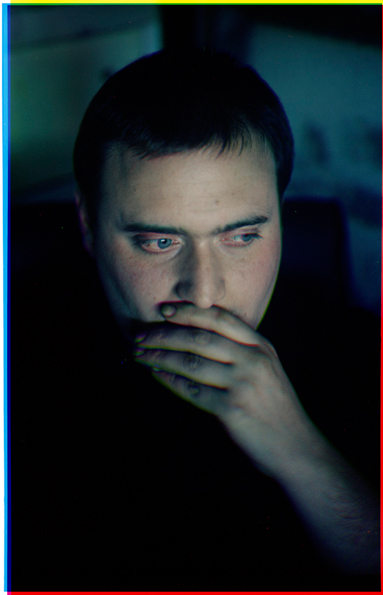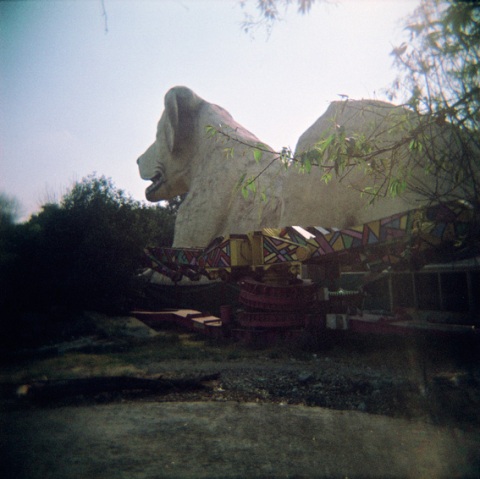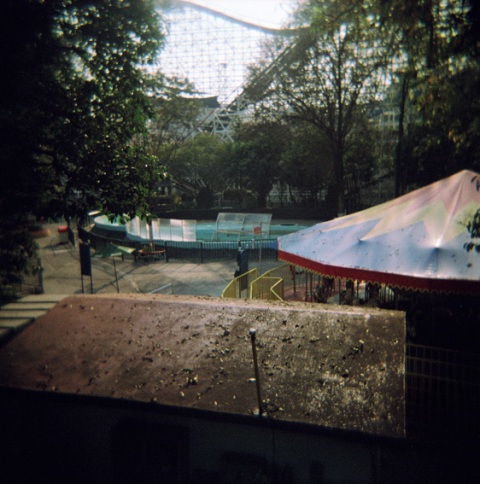December 2007
December 25, 2011
December 2007 I was in Mexico City for 5 weeks. The above sequence is pretty typical of my daily wanderings. I did a lot of walking there, probably 10 to 15 km per day. Most of the photos above were made with the Nikon 28Ti, with a mix of Fuji Superia 400 and 1600, some Provia 400 pushed to 1600 in E6 and some cross processed Agfa Precisa.
Beetles in D.F.
December 13, 2009
Yeah, there’s a lot of Volkswagens in Mexico City, just like there’s a lot of motor scooters in Hanoi, which makes me feel compelled to take photos of them. Above was in Zona Rosa, very close to the vegetarian restaurant Yug, it was parked in that spot every time I ate there. This photo was cross processed Agfa RSX through a Holga. Below was at Parque Mexico, near Sonora in the Hipodromo district, cross-processed Agfa Precisa in the Nikon 28ti.
Near Zocalo
December 13, 2009
I took this photo almost 2 years ago, it was Jan ’08 near the Zocalo in Mexico City with the cathedral behind me and Templo Mayor to my left. This was cross processed film, probably Agfa RSX. It was shot with a Holga that had a wonky lens as a result of me trying to force a Cokin filter holder onto it. The lens was at an angle to the body for several weeks until I bought a screwdriver, popped it out & reinserted the lens. That’s the reason for extra blurring distortion in the lower corners.
The Collection of a Gentleman
May 13, 2009
One of my art projects is being exhibited in Sydney until Sunday 24th May. The show consists of 44 portrait drawings of myself that I had made by street artists in 7 cities in 6 countries; Sydney, Los Angeles, Mexico City, Kuala Lumpur, Hanoi, Chiang Mai and Bangkok.
While observing two street portrait artists at work in Paris in September 2000 I had the idea that it might be interesting to have multiple realistic portraits made of myself in different parts of the world. My thought was that comparing the final results could reveal some of the complexity of what happens in a portrait.
From it’s beginning a portrait embodies uncertainty. The artist observes the sitter and then moves their eye to the paper and makes their mark using a combination of memory and technique. There are further complications when a third party viewer looks at the finished work, as we experience portraits in a different way than we do landscape or still life. We see the portrait as a work of art but also as a person and will assess the face in the picture in the same way that we do when facing someone. There is the illusion that we are looking at them solely with our own subjectivity when in fact we are also looking through the eyes and memory of the artist who made the portrait.
The work is at the exhibition gallery inside the Sydney Antique Centre, 531 South Dowling St, Surry Hills. Open 7 days from 10-6.
Tri-colour exposures
May 8, 2009
This is a colour photography process I’ve been exploring off and on for the past couple of years. Essentially it is making colour photos using black & white film. It’s an interesting way to learn how colour images are constructed in both film & digital photography. It is basically the same process used by early colour experimenters such as James Clerk Maxwell and is based on the understanding that the primary colours of light are RGB; red, green and blue, and that filters of these colours can pass the wavelengths that match and block those that don’t. The simple example is that a red filter allows the red light (wavelengths) to pass through while absorbing (blocking) the blue.
Hence this process is known as tri-colour as we have to make three exposures to record the full range of light. One exposure through a red filter, one through green and one through a blue filter. So we have 3 B&W negs that are colour separations of the whole & need to be re-combined to make a colour photo. There are some gum printing processes where this can be done direct to paper, however the most common method & the one I’m displaying here is to scan the film & combine the colour layers in Photoshop.
detail of my room in Hotel Roble, Mexico City. I liked the peacock tail effect the maids would make with the toilet paper roll.
The first step is to get some filters that will go in front of the lens for each shot. I use a 1920s Voigtlander Avus, for various reasons but one of them is that it has a small lens diameter (approx 26mm) so only needs small filters. It also has an extending lens bed so rather than having to source filters to fit over the lens I could make them in a cardboard mount that sits on the lens bed, as long as I’m shooting vertical frames. The filter sizes are so small that I was able to get them for free from a Lee filters sample swatch book that was given to me by Panavision. The next step is to establish the filter factor for each filter, i.e. how much light does it block that needs to be compensated for to obtain correct exposure. I metered through each filter with a spot meter and found that the Red filter needs 3 stops extra light, the Green requires 4 extra and the Blue gets plus 5 stops.
To make a photo I set the camera on a tripod, get the framing right & do some basic metering as if I was exposing B&W film normally. The Voigtlander was made to shoot 6.5 x 9 cm glass plates but mine also came with a 120 film back that shoots 6 x 9 cm frames. I always expose in RGB order & adjust the basic meter reading by the filter factor. For example if the normal exposure would be f/8 at 1/60 sec, I would expose R at 1/8, the G at 1/4 and the B at 1/2 sec. 6×9 on 120 gets me 8 frames so I generally shoot one frame without the filters at the base exposure as a reference.
portrait of Steve
The process described above is exactly how regular colour film works except there the 3 layers are exposed simultaneously and in perfect registration. With tri-colour the exposures are sequential so if something in the scene moves betwen frames it will result in a colour shift when they are combined. This has interesting implications for subjects like portraiture and is an area I intend to explore further.
Un Perro Grande
April 16, 2009
Another couple of photos taken at Chapultepec 2, not far from the amusement park. This was taken with a Holga loaded with Agfa RSX slide film that was then processed through C-41 chemistry. I’m not sure what the name of the place was, it was some kind of amusement centre although I got the feeling it was mostly aimed at kids. The first time I saw it was from the top deck of the Turibus & I noticed this giant model dog & not far away was a scale model of Mexico City. I thought there might be potential to take a photo with the giant dog looming up behind the city buildings. That’s one of the reasons why I went back but as with the amusement park this place was closed on Mondays so I could only take photos from outside. When I was framing up the top shot I was hoping that someone would walk into frame to give a sense of scale but the area was pretty dead that day. There was no one around so I took it as is. I left a few days later & never got a chance to go back.
I had the film processed & proofed at LMI, the main pro lab in the city. I don’t think they were used to cross processing as they got the colour quite wrong on the proof sheets. It was very yellow & contrasty. I’ve re-proofed a couple of rolls in a Sydney colour darkroom & managed to get them looking more like what you see here.
La Feria de Chapultepec
February 21, 2009
I took these photos in Jan ’08 at the amusement park in the second section of Chapultepec park, Mexico City. I’d been past the previous week on the top deck of the Turibus & saw possibilities for photos. I went back on a Monday planning to pay entry to the park & walk around taking photos but it turned out to be closed on Mondays, so I had to walk around the outside & shoot over the fence.
The shot above is the Raton Loco (Crazy Mouse) & below is montana Rusa (Russian mountain, the Mexican name for roller coasters). Both photos were taken with a Holga exposing Agfa RSX transparency film that was cross processed in C-41 chemistry to a negative.I had all my film processed at a good pro lab, LMI, Laboatorio Mexicano de Imagenes, in Hipodromo Condesa. I think they are the best lab in Mexico City.
Restaurante Vegetariano
February 6, 2009
This was where I had breakfast on my first day in Mexico City. It was on Calle Filomeno Mata, between Av Cinco de Mayo & Calle Tacuba, in the Centro Historico area. I liked the old saloon style chairs. The murky colour of the light is from the fluoros. I think I shot this on Fuji Provia 400, sort of wish I’d gone back to try again with colour negative film to see how different it looked. The food wasn’t that great so I didn’t have much desire to return. It was vegetarian but the menu was pretty heavy on eggs & cheese. I ended up eating a lot at the VIPs down the road where they had a few good vegetarian options & it was much better for people watching. And then I got hip & moved to Colonia Roma.
Traffic Cops
December 9, 2008
Mexico City Jan ’08 Nikon 28ti Agfa Precisa
Traffic cops in Centro Historico, think I shot this from the hip as I was nervous about their reaction if they saw me photographing them. Colour intensity is from cross processed Agfa Precisa & the mixture of city evening light colours.
I was intrigued by the number and variety of police in Mexico City, apparently there are something like 80,000 of them. These are the traffic police and wear uniforms that look a bit naval. They have certain hand gestures for signalling vehicles to move through. Fingers pointing down & fanning the hand from the wrist. I read that the way traffic police signal in the west is regarded as an obscene gesture in Mexico although I never followed up on that. Most of these traffic police are women. It didn’t look like a fun job; they’d be breathing heavy pollution all day, bombarded by noise & trying to sort out the traffic chaos which is extreme at peak hour. Still, they’re probably grateful to have a steady job.
Hotel
November 28, 2008
Colonia Roma, Mexico City Jan ’08 Nikon 28ti
This was the view from my window at the Hotel Milan on Alvaro Obregon, colonia Roma. Nice view of a pleasant street but it was noisy & I soon moved to a room at the back. Traffic noise all night. Shame, with double glazing it would have been perfect. This was a good hotel in a good location & I stayed there for three weeks. It was a 10 minute walk to Insurgentes metro station & Zona Rosa. Zona Rosa is basically a dump but there was a good vegetarian restaurant there named Yug. Also from Roma I could walk 15 minutes to Insurgentes Sud & take the metro bus to Condesa which is another nice area with good places to eat. I think the film used for this shot was Fuji Superia 400 or 800, that’s what I mostly used there. I had all my film processed at the LMI lab where they did a good job.


